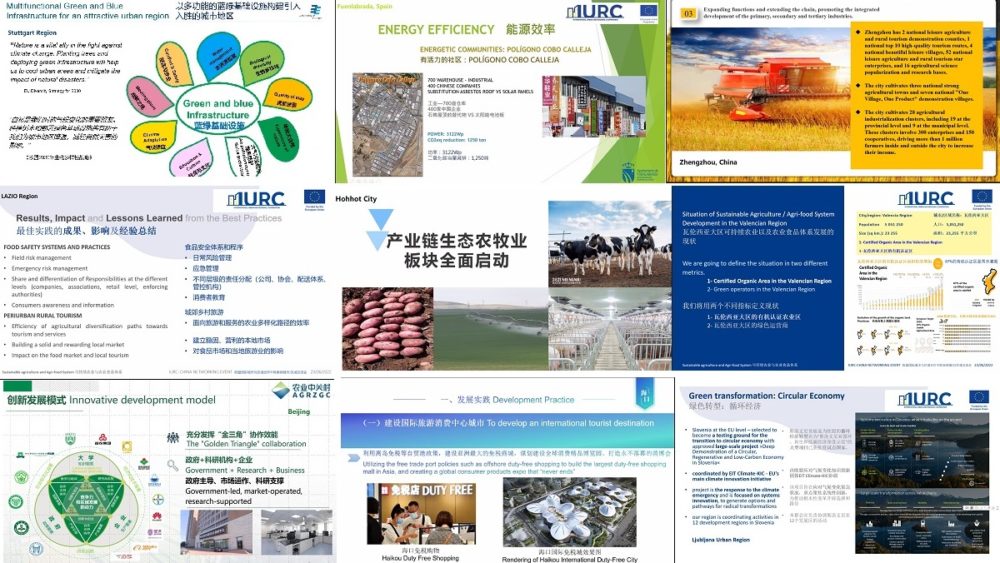In IURC-China, the European and Chinese pilot cities and regions are facing similar challenges in urban transformation, industrial upgrading and environmental sustainability, albeit in varying social and economic contexts. They are keen to learn from each other’s good practices, share experiences and find common solutions through IURC-China networks. We underline some exciting findings and lessons learnt from our activities since the project kicked off at the end of 2021.
- Share the transferable models
The best practice is context specified. A solution that worked in Europe doesn’t mean it can be merely applied in China, and vice versa. The urban learning process is complex, especially when good practice is related to system change. IURC-China focuses on distilling the transferable model, which could be adopted and adapted in other cities. The cooperation webinar on the Nature-based Solutions and Circular Economy (25-03-2022) aims to unravel nature-based solutions and circular city concepts for better local impact. Stuttgart has shared its approach to blue and green infrastructure planning. The city´s urban ventilation corridor plan demonstrates the potential to localise in the planning of Nanchang Wuhan, and Chengdu; The circular economy model in Fuenlabrada has the potential to be rewired in Zhengzhou as a starting point to deeper cooperation.
- Unravel the success stories in multiple ways
The distilled good practice models interact with the local context and can be unravelled in multiple ways. The sustainable agriculture and agri-food system, led by the Lazio region as its strategic sector, provides a good example. To accelerate the transferring of the good practice model, the different elements are identified for the role of the agri-food system in cultural heritage, tourism and creative industry, circular economy, ecosystem and rural-urban development. It creates a network of key regional organisations such as associations, universities and businesses. There, Beijing, Haikou and Hohhot have identified effective intervention tools to incorporate into their pilot projects, leading to partnerships with the Lazio region.
- Find the spark
Even with similar goals between the European and Chinese cities and regions, a good practice model won’t be simply transferred without encountering local resistance. IURC-China team identifies the cooperation areas in a pragmatic approach. When the innovative solution from the “supply-side” aligns with the strategies of the “demand-side”, the distilled best practice model can be quickly rolled out in joint actions through the IURC platform. For example, Valencia presents a leading role in organic farming-related certification, innovation, training, and resource (energy, water, soil) management. It aligns with the development of organic medium-small farms in China, especially in suburbs of megacities; Both Haikou and Western Greece Region presented interests in blue-economy-related sustainable development, including aquaculture-agriculture, coastal tourism, green harbour development, renewable energy and energy efficiency. Ljubljana Urban Region is leading an EU-funded circular economy project and is keen to incorporate good practices from China; Tianjin Sino-German Eco-city is looking for solutions toward low-carbon pathways based on experience from German cities.
- Transformation starts from experimental projects
IURC-China is not only a network for cities and regions to share experiences and perspectives but also a platform to facilitate and develop experimental pilot projects. For example city of Sofia supports innovation in energy efficiency and education in kindergarten. Within this framework, Chinese cities, i.e., Qingdao, which developed large passive house compounds, and Guangzhou with energy efficiency assessment in education programme on agenda, can partner for piloting an experimental project, incorporating Sofia city´s concept and explore further.
Western Greece supports energy efficiency in public buildings. This can be a joint experimental program partnered with Chinese cities with similar climate situations, whereas the passive house and low-energy house concepts have been developed for the cold climate of central Europe.
What happens next?
In IURC China, we have developed a network of “knowledge-sharing, peer-to-peer cooperation, and scaling-up solutions”. All the exchanges and success stories achieved in the previous phase are continuously leading to concrete peer-to-peer cooperation. Considering the foreseen possibilities for study visits in the next six months, the pilot cities and regions will be provided more opportunities to formulate joint actions, adopt and adapt the good practice models and concepts, endeavour to meet sustainable goals and build a strong cooperation network between the EU and China.
For more information, and cooperation inquiries, please get in touch with us at info-china@iurc.eu
